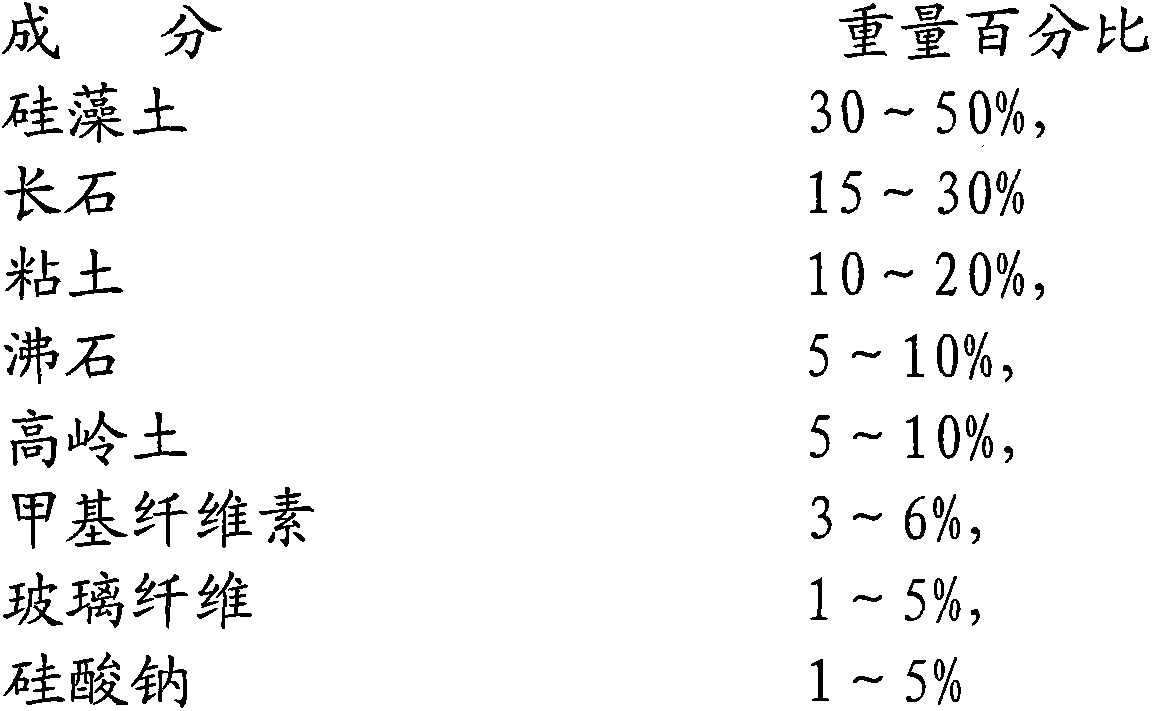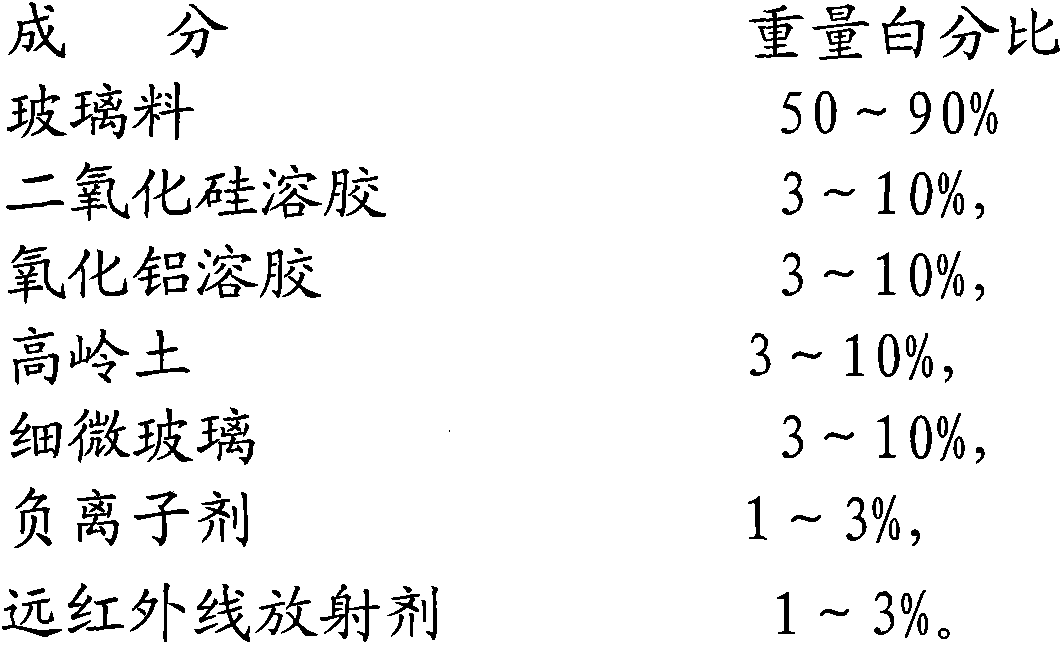Method for producing ceramic tiles with absorption and release functions by using kieselguhr as main component
A technology of diatomaceous earth and functional function, which is applied in the field of making micro-porous tiles, which can solve the problems of not ideal tiles, poor performance of cold insulation, heat insulation and sound insulation, and dew condensation on the glazed surface of tiles.
- Summary
- Abstract
- Description
- Claims
- Application Information
AI Technical Summary
Problems solved by technology
Method used
Image
Examples
Embodiment 1
[0020] 1-1) Take 300 kg of diatomite, 200 kg of feldspar, 200 kg of clay, 100 kg of zeolite, 100 kg of kaolin, 30 kg of methyl cellulose, 40 kg of glass fiber and 30 kg of sodium silicate with reference content. After being crushed into materials below 325 mesh. Add 450 kg of water and put it into an automatic slurry mixer to stir for 8 hours.
[0021] 1-2) The mixed material is then spray-dried to produce a powder with a moisture content of 7%, a particle size of 5% above 0.5mm, and 2% below 0.08mm.
[0022] 1-3) Put the above powder into a hydraulic press at a rate of 350kg / cm 2 The pressure is pressed into a semi-finished product with a size of 100mm×100mm×6mm, and it is fired at a maximum firing temperature of 750°C for one hour.
[0023] 1-4) Glaze production
[0024] Get 70 kilograms of glass frit of standard content, 10 kilograms of kaolin, 5 kilograms of glass powder, 10 kilograms of silica sol, 2 kilograms of negative ion agent, 3 kilograms of far-infrared radiatio...
Embodiment 2
[0027] 2-1) Take 360 kg of diatomite, 250 kg of feldspar, 150 kg of clay, 70 kg of zeolite, 50 kg of kaolin, 50 kg of methyl cellulose, 40 kg of glass fiber and 30 kg of sodium silicate as raw materials for the standard content. Mix and pulverize, then add 500 kg of water and put it into an automatic mixer and stir for 8 hours.
[0028] 2-2) The mixed raw materials are then spray-dried to produce a powder with a moisture content of 7%, a particle size of 5% above 0.5mm, and 2% below 0.08mm.
[0029] 2-3) Put the above powder into a hydraulic press. at 400kg / cm 2 The pressure is pressed into a semi-finished product with a size of 100mm×100mm×6mm, and the finished product is fired at a maximum firing temperature of 750°C for one hour.
[0030] 2-4) Glaze production
[0031] Get 75 kilograms of glass frits of benchmark content, 5 kilograms of kaolin, 5 kilograms of glass powders, 10 kilograms of silica sols, 2 kilograms of negative ion agents, and 3 kilograms of far-infrared...
Embodiment 3
[0034] 3-1) Take 420 kg of diatomite, 200 kg of feldspar, 150 kg of clay, 50 kg of zeolite, 50 kg of kaolin, 40 kg of methyl cellulose, 40 kg of glass fiber, and 50 kg of sodium silicate as raw materials for the standard content. Mix and pulverize, then add 450 kg of water and put it into an automatic mixer to stir for 8 hours.
[0035] 3-2) After stirring, the mixed raw materials are spray-dried to prepare a raw material powder with a water content of 9%, a particle size of 5% above 0.5mm, and 2% below 0.08mm.
[0036] 3-3) Put the above powder into the hydraulic press at 420kg / cm 2 The pressure is pressed into a semi-finished product with a size of 100mm×100mm×6mm, and the semi-finished product is fired at a maximum firing temperature of 750°C for one hour.
[0037] 3-4) Glaze production
[0038] Get 70 kilograms of glass frit of standard content, 10 kilograms of kaolin, 10 kilograms of glass powder, 5 kilograms of silica sol, 2 kilograms of negative ion agent, 3 kilograms...
PUM
 Login to View More
Login to View More Abstract
Description
Claims
Application Information
 Login to View More
Login to View More - R&D
- Intellectual Property
- Life Sciences
- Materials
- Tech Scout
- Unparalleled Data Quality
- Higher Quality Content
- 60% Fewer Hallucinations
Browse by: Latest US Patents, China's latest patents, Technical Efficacy Thesaurus, Application Domain, Technology Topic, Popular Technical Reports.
© 2025 PatSnap. All rights reserved.Legal|Privacy policy|Modern Slavery Act Transparency Statement|Sitemap|About US| Contact US: help@patsnap.com



